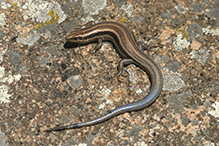Common Five-lined Skink
(Plestiodon fasciatus)
Conservation • Description • Habitat • Biology • Distribution • Taxonomy
Conservation Status |
|
|||||||
| IUCN Red List | LC - Least Concern |
|||||||
| NatureServe | N5 - Secure S3 - Vulnerable |
|||||||
| Minnesota | Special Concern Species in Greatest Conservation Need |
|||||||
Description |
||
The upper (dorsal) surface has 5 distinct yellow stripes running from the head to the tip of the tail. The central stripe splits in two forming a "Y" on the top of the head. Juveniles have a bright blue tail. Adult females have a bluish-gray tail. Adult males have a gray tail. |
||
Size |
||
5″ to 8½″ |
||
Similar Species |
||
Prairie skink (Plestiodon septentrionalis) lacks the "Y" shaped mark on the top of the head. Six-lined racerunner (Aspidoscelis sexlineatus) has three stripes on each side. |
||
Habitat |
||
Moist but not wet wooded areas with rock outcrops, including bluffs, forest edges, and savannas. |
||
Biology |
||
Behavior |
||
When attacked by a predator, the skink will detach its tail. The tail will continue to wiggle and distract the predator while the skink seeks cover. The tail will regrow but will not be as long or as colorful as the original. |
||
Lifespan |
||
5 to 7 years |
||
Life Cycle |
||
|
||
Food |
||
Crickets, grasshoppers, beetles, caterpillars, and other insects; spiders; and snails. |
||
Distribution |
||||
|
Sources |
|||
| 1/7/2023 | ||||
Occurrence |
||||
Scattered populations in only seven or eight Minnesota counties |
||||
Taxonomy |
|||
| Class | Reptilia (Reptiles) | ||
| Superorder | Lepidosauria | ||
| Order | Squamata (Snakes and Lizards) | ||
| Suborder | Lacertilia (lizards) | ||
| Infraorder | Scincomorpha (skinks, wall lizards, and relatives) | ||
| Superfamily | Scincoidea | ||
Family |
Scincidae (skinks) | ||
Subfamily |
Scincinae (typical skinks) | ||
Genus |
Plestiodon (toothy skinks) | ||
Five-lined skink was formerly classified as Eumeces fasciatus. Recently, two separate studies, Smith (2005) and Brandley et al. (2005), proposed separating all species in North America north of Mexico into the genus Plestiodon. This was accepted by Crother (2008) and by Collins and Taggart (2009). Most sources now use this new classification. ITIS still classifies North American skinks in the genus Eumeces. |
|||
Subordinate Taxa |
|||
|
|||
Synonyms |
|||
Eumeces fasciatus Lacerta fasciata |
|||
Common Names |
|||
American five-lined skink blue-tailed skink Common Five-lined Skink five-lined skink |
|||
Visitor Photos |
|||||
Share your photo of this reptile. |
|||||
| This button not working for you? Simply email us at info@MinnesotaSeasons.com. Attach one or more photos and, if you like, a caption. |
|||||
Jeff LeClere |
|||||
 |
|||||
MinnesotaSeasons.com Photos |
|||||
|
|||||

Slideshows |
||

Visitor Videos |
|||
Share your video of this reptile. |
|||
| This button not working for you? Simply email us at info@MinnesotaSeasons.com. Attach a video, a YouTube link, or a cloud storage link. |
|||
Other Videos |
|||
| Blue-tailed Plestiodon fasciatus Creepy, Funny, and Crazy Videos |
|||
About
Published on Jul 29, 2015 Blue-tailed Plestiodon fasciatus Filmed: July 4, 2009 |
|||
| American five-lined skink piranhacam72 |
|||
About
Published on Aug 23, 2014 Plestiodon fasciatus (American five-lined skink) pays us a visit. |
|||
| The Five-lined Skink - Russell Cave National Monument NPS Inventory and Monitoring |
|||
About
Published on Nov 20, 2012 Video describing the biology and natural history of the five-lined skink, a common reptile at Russell Cave National Monument. |
|||
| The Five-Lined Skink globalzoo |
|||
About
Uploaded on Jan 21, 2010 This is a video of the five-lined skink from the BBC's Life in Cold Blood documentary series. |
|||
| American five-lined skink, Juvenille southcoastms |
|||
About
Published on Jul 26, 2013 Plestiodon fasciatus July 25, 2013, Ocean Springs, Mississippi Juvenilles have the bright blue tail. Adults swap the blue tail for red coloring on the head. This one was sweeping his tail back and forth until I grabbed the video camera, when he froze in place for a several minutes and finally did one tail sweep. I can't imagine why they do that. It seems like that brightly colored moving tail would be a "come eat me" signal to every coon, snake, and bird nearby. |
|||

Last Updated:


